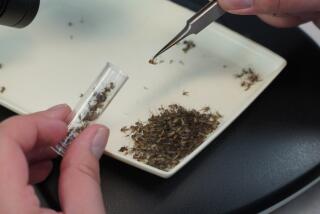Technology of U.S. Spy Plane Used to Wage Malaria War
SAN FRANCISCO — The same high-flying technology that has enabled governments to spy on each other’s military forces is now being directed against one of mankind’s most deadly and intransigent enemies--malaria.
Using American and French satellites and a civilian version of the U-2 spy plane, scientists are developing a method of predicting where and when malaria-carrying mosquitoes will strike.
The war against the Anopheles mosquito is a critical one: More than half of the world’s population lives in areas where the insects are found. World health experts expect more than 100 million new cases of the disease and about 1.5 million deaths this year alone.
American scientists are spearheading the high-tech war against the mosquito, and numerous foreign governments and international agencies, including the U.N. Committee on the Peaceful Uses of Outer Space, are watching its progress.
For the last four years, scientists have studied in minute detail aerial photos taken of about 100 rice fields in California’s Sacramento Valley and correlated the fields’ characteristics with the appearance of mosquitoes.
They now say they can predict--two months in advance and with greater than 83% accuracy--the exact locations where Anopheles mosquitoes will breed.
Breed in Limited Areas
The precision is required because researchers long ago discovered that the insects, which carry the parasite that causes malaria, breed in limited areas.
Of 104 California rice fields studied, only 16 accounted for half of the mosquito population.
Armed with that knowledge, the scientists think they can develop for every region of the globe infected with malaria--mainly those countries near the Equator--the means to predict and plan for mosquito infestations.
“We’re talking in the first week of May about what’s going to happen in the latter part of July and August,” Robert Waschino, one of the project’s scientists, said in a recent telephone interview. “Now, that’s real magic.”
Waschino, an entomologist at the University of California at Davis and one of the world’s leading experts on the Anopheles mosquito, and his colleagues plan to start correlating the satellite and aircraft data with insecticide spraying in California this year.
They are using data gathered by aerospace scientists at Ames Research Center, a NASA facility at Mountain View, Calif.
A second phase of the fight against malaria already has been started in Mexico. A third phase, due to start sometime in the 1990s, will be able to cover every country identified by the World Health Organization as being at high risk for malaria.
To Expand Study Area
Paul Sebasta, a NASA ecologist and the project’s manager, said scientists are now studying a 36-square-mile plot of land near Tapachula, in Mexico’s Chiapas state. Once the hydrology and vegetation of the targeted land is known, the size of the study area will be enlarged.
By learning myriad details about land and vegetation features, the scientists said they can predict where the heaviest of the mosquito populations will emerge. “We are confident we can do this,” said Sebasta, “and we want to take the lessons we’ve learned here in California and apply them to Mexico.”
The conventional method requires that inspectors test rice fields and other potential breeding grounds first-hand, using small dippers to scoop up water that is then examined for mosquito larvae. It is a crude, slow and costly process.
Furthermore, the current means of hunting for the breeding grounds provides little predictability, said Waschino.
“In a field with a low density of Anopheles, to get the kind of precision you need you may have to dip a thousand times. And that’s just one field,” he said.
The scientists hope that in the mid-1990s they will be able to detect mosquito breeding grounds from a satellite permanently orbiting the Earth.
“Our ultimate goal is to be able to say, for instance, that based on satellite data, breeding conditions will be perfect in four weeks for certain species of malaria-bearing mosquitoes,” said Sebasta. “We won’t really be able say the disease is there, but we can say the potential is there.”






